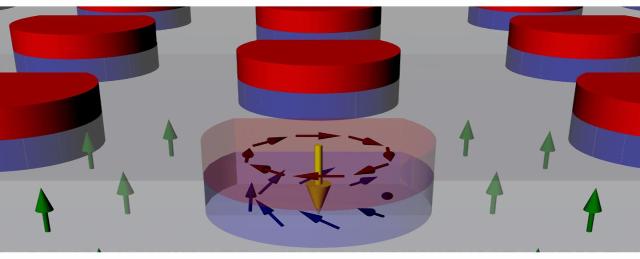Oct 12 2015
An exotic, swirling object with the sci-fi name of a "magnetic skyrmion" could be the future of nanoelectronics and memory storage. Physicists at UC Davis and the National Institute of Standards and Technology (NIST) have now succeeded in making magnetic skyrmions, formerly found at temperatures close to absolute zero, at room temperature.
 Magnetic skyrmions are a type of swirling magnetic structure that maintains its topology. Physicists at UC Davis and NIST have developed nano dots that induce magnetic skyrmions in a film (arrows show magnetic moments). Credit: Kai Liu/UC Davis
Magnetic skyrmions are a type of swirling magnetic structure that maintains its topology. Physicists at UC Davis and NIST have developed nano dots that induce magnetic skyrmions in a film (arrows show magnetic moments). Credit: Kai Liu/UC Davis
"This is a potentially new way to store information, and the energy costs are expected to be extremely low," said Kai Liu, professor of physics at UC Davis and corresponding author of a paper on the work, published in the journal Nature Communications Oct. 8.
Skyrmions were originally described over 50 years ago as a type of hypothetical particle in nuclear physics. Actual magnetic skyrmions were discovered only in 2009, as chiral patterns of magnetic moments -- think of a moment as a tiny compass needle -- in materials close to absolute zero temperature, in the presence of a strong magnetic field.
Magnetic skyrmions fall into two types, Liu said: "Bloch skyrmions," with a hurricane-like spiral pattern of magnetic moments around a perpendicular center, surrounded by magnetic moments oriented in the opposite direction to the center; and "hedgehogs," where the magnetic moments orient like spikes on a hedgehog or sea urchin.
The interesting thing about magnetic skyrmions, Liu said, is that they are "topologically protected:" they can be continuously deformed, in the same way that a coffee mug shape can be deformed into a bagel shape, but they do not readily go back into a state where all the magnetic moments are aligned. That means they can potentially store information at an energy cost much lower than current technology, Liu said.
Together with graduate student Dustin Gilbert, now a postdoctoral fellow at NIST, Liu and colleagues designed a nanosynthesis approach to achieve artificial "Bloch" magnetic skyrmions at room temperature. They created a pattern of magnetic nanodots, each about half a micron across, on a multilayered film where the magnetic moments are aligned normal to the plane. They used ion beam irradiation to modify the interface between the dots and the film to allow "imprinting" of the magnetic moments of the dots into the film.
Using neutron-scattering at NIST Center for Neutron Research, they were able to resolve the magnetic profiles along the depth of the hybrid structure. Combined with magnetic imaging studies at NIST and Lawrence Berkeley Laboratory, they were able to find the first direct evidence of arrays of stable spiral magnetic skyrmions beneath the nanodots at room temperature, even without an external magnetic field.
The availability of stable magnetic skyrmions at room temperature opens up new studies on their properties and potential development in electronic devices, such as nonvolatile magnetic memory storage.
Coauthors on the paper are Brian Maranville, Andrew Balk, Brian Kirby, Daniel Pierce, John Unguris and Julie Borchers at NIST, and Peter Fischer, LBL and UC Santa Cruz. Nanofabrication work and other characterizations were carried out in Liu's laboratory and at the Center for Nano and Micro Manufacturing at UC Davis. The work was funded by the National Science Foundation.